CT’s state flower, the mountain laurel, is at peak bloom in some areas; where to see it
CT Insider – Heather Zidack and other professionals discuss Connecticut’s State Flower, the Mountain Laurel and where to see it in bloom this spring.
Web cookies (also called HTTP cookies, browser cookies, or simply cookies) are small pieces of data that websites store on your device (computer, phone, etc.) through your web browser. They are used to remember information about you and your interactions with the site.
Session Management:
Keeping you logged in
Remembering items in a shopping cart
Saving language or theme preferences
Personalization:
Tailoring content or ads based on your previous activity
Tracking & Analytics:
Monitoring browsing behavior for analytics or marketing purposes
Session Cookies:
Temporary; deleted when you close your browser
Used for things like keeping you logged in during a single session
Persistent Cookies:
Stored on your device until they expire or are manually deleted
Used for remembering login credentials, settings, etc.
First-Party Cookies:
Set by the website you're visiting directly
Third-Party Cookies:
Set by other domains (usually advertisers) embedded in the website
Commonly used for tracking across multiple sites
Authentication cookies are a special type of web cookie used to identify and verify a user after they log in to a website or web application.
Once you log in to a site, the server creates an authentication cookie and sends it to your browser. This cookie:
Proves to the website that you're logged in
Prevents you from having to log in again on every page you visit
Can persist across sessions if you select "Remember me"
Typically, it contains:
A unique session ID (not your actual password)
Optional metadata (e.g., expiration time, security flags)
Analytics cookies are cookies used to collect data about how visitors interact with a website. Their primary purpose is to help website owners understand and improve user experience by analyzing things like:
How users navigate the site
Which pages are most/least visited
How long users stay on each page
What device, browser, or location the user is from
Some examples of data analytics cookies may collect:
Page views and time spent on pages
Click paths (how users move from page to page)
Bounce rate (users who leave without interacting)
User demographics (location, language, device)
Referring websites (how users arrived at the site)
Here’s how you can disable cookies in common browsers:
Open Chrome and click the three vertical dots in the top-right corner.
Go to Settings > Privacy and security > Cookies and other site data.
Choose your preferred option:
Block all cookies (not recommended, can break most websites).
Block third-party cookies (can block ads and tracking cookies).
Open Firefox and click the three horizontal lines in the top-right corner.
Go to Settings > Privacy & Security.
Under the Enhanced Tracking Protection section, choose Strict to block most cookies or Custom to manually choose which cookies to block.
Open Safari and click Safari in the top-left corner of the screen.
Go to Preferences > Privacy.
Check Block all cookies to stop all cookies, or select options to block third-party cookies.
Open Edge and click the three horizontal dots in the top-right corner.
Go to Settings > Privacy, search, and services > Cookies and site permissions.
Select your cookie settings from there, including blocking all cookies or blocking third-party cookies.
For Safari on iOS: Go to Settings > Safari > Privacy & Security > Block All Cookies.
For Chrome on Android: Open the app, tap the three dots, go to Settings > Privacy and security > Cookies.
Disabling cookies can make your online experience more difficult. Some websites may not load properly, or you may be logged out frequently. Also, certain features may not work as expected.
CT’s state flower, the mountain laurel, is at peak bloom in some areas; where to see it
CT Insider – Heather Zidack and other professionals discuss Connecticut’s State Flower, the Mountain Laurel and where to see it in bloom this spring.
By Heather Zidack, UConn Home & Garden Education Center
If you’re planning to do some landscape renovations this summer, you will often hear the suggestion of doing certain tasks “until the plant is established.” If you’ve heard this phrase and wondered what the pros mean, you’re not alone. It’s crucial to understand that the first year of growth is one of the most critical to ensure the success of trees, shrubs and perennials in the landscape.
The “establishment period” is when a newly transplanted plant pushes roots beyond the original root ball to anchor itself into the surrounding soil and adapt to its new environment. Establishment happens in as little as 2-4 weeks for your veggie starts and other annuals. However, if you are installing woody ornamentals or perennials, it is recommended to provide support for their first year in the landscape. Some species, especially fruiting plants may need longer attention to ensure establishment and landscape success.
Keeping the plants properly hydrated is going to be your first line of defense in preventing transplant shock. Using sprinkler systems for supplemental water can be problematic for trees, shrubs and perennials. These systems, especially those designed for lawns, maintain moisture in the top 1-2 inches of soil. Our non-turf plants need much more. Providing adequate water will help new plants acclimate by providing sufficient hydration, but it will also encourage the root system to expand. Roots pull moisture and nutrients from the soil but also act as an anchor to keep the plants upright. Keeping only the top few inches of soil moist will encourage roots to stay in that shallow layer instead of expanding deeper into the soil, hindering the development of that anchoring system. Additionally, watering demand tends to be more frequent with shallow root systems, as the first few inches of soil are more susceptible to drying out on sunny days. Lastly, the shallow roots need to compete with established turf for resources at a 1-2-inch depth.
While in this establishment period, the standard watering recommendation is 1-2 inches per week, depending on the species of plant. An inch of water is equivalent to 0.62 gallons per square foot of garden area. Watering the plant at this rate encourages it to stretch its roots downward into the soil. With deeper roots, plants can find moisture even during times of temporary drought deep below ground. This is a huge contribution to drought tolerance, as opposed to the common belief that the plant will just “live longer without water.”
If the forecast does not predict an inch of rain within the week, gardeners should be out checking the soil for moisture a few inches down and providing supplemental water if necessary. Always check the soil before watering, especially if you are new to gardening. Squeeze the soil in your hand. If the soil particles stick together easily, it is likely that there is enough moisture. If soil clumps fall apart between your fingers or the texture is dusty, the soil is too dry and more water is needed. If you can squeeze water out of the soil like a sponge, there is too much moisture, and you should come back and check in a day or two. Overwatering can lead to root rot and other diseases and finding the balance is a fine-tuned skill developed over time.
Monitor your new plantings for the first year and watch for signs of transplant shock, pests and disease so that you can adjust quickly and keep your plants healthy during this time. While transplant shock is a normal response to being planted in a new location, the symptoms can be startling to gardeners. Remember that the UConn Home & Garden Education Center is here to help you determine if you are looking at transplant shock, disease, or possible pest damage. It’s easier to catch and treat issues earlier than it is to react at the end of the season. If you’re vigilant, we can help you find your way to solutions much more quickly!
Staking should only be done as a temporary measure for young trees where the environment or the species of tree requires extra support. In most cases, trees should be perfectly capable of supporting themselves. Exposure to the elements, like the occasional strong breeze, can help to strengthen them as they adjust. However, temporary staking can help take some of the stress off the young trees if they are establishing in harsher environments. While there are many situations that may be appropriate, consider staking newly planted trees when they are in open areas, have high wind exposure, or are in an area that risks mechanical or physical damage. Staking may also be appropriate if the root ball is significantly smaller in relation to the tree’s size, or if the tree has a top-heavy canopy.
Once your plants are well anchored into your landscape, they will be able to find water and nutrients on their own while standing tall in the face of our New England climate. Putting in the attention and care to help plants establish in their first year or two in the landscape will reward you with many years of enjoyment to come.
The UConn Home & Garden Education Center supports UConn Extension’s mission by providing answers you can trust with research-based information and resources. For gardening questions, contact us toll-free at (877) 486-6271, visit our website at homegarden.cahnr.uconn.edu, or reach out to your local UConn Extension center at cahnr.uconn.edu/extension/locations.
This article was published in the Hartford Courant June 7, 2025

In June as many as a dozen species may burst their buds on a single day. No man can heed all of these anniversaries; no man can ignore all of them.
— Aldo Leopold, "Prairie Birthday"

With summer sunshine finally arriving in Connecticut, it’s a great time to give your indoor houseplants a seasonal boost. The increased sunlight, warmer temperatures, and higher humidity can help your plants thrive—but only if they’re eased into the change. Like people, houseplants need time to adjust to new conditions in order to succeed in them.
To help them transition from indoors to outdoors, start by placing them in shaded areas. If desired, you can gradually increase their sun exposure over about two weeks. This slow adjustment helps prevent sunscald, a common issue when plants are suddenly exposed to much stronger light, similar to a sunburn. Keep in mind that even the brightest indoor spots receive far less light and radiation than full sun outdoors. Therefore, many houseplants do best in full shade or indirect light all summer, while some can tolerate part shade once properly acclimated.
To keep your plants happy and hydrated, place them somewhere visible so you’re reminded to check on them regularly. With more sunlight and warmth, they’ll likely be pushing out new growth, and will need water more often. Check the soil daily during hot, sunny weather to prevent drying out and ensure a smooth adjustment to their new environment.
Pruning spring flowering shrubs is an essential aspect of maintaining a healthy and vibrant garden. Early spring is typically the ideal time for pruning these shrubs, as it allows for healthy growth and better blooms during the upcoming season.
When pruning these shrubs, focus on removing any dead, damaged, or diseased wood, as well as any crossing branches that may cause damage or hinder growth. It's important to keep in mind that each shrub has its own unique pruning requirements based on its growth habits and flowering times. For example, early-flowering shrubs should be pruned after their blooms have faded, while late-flowering shrubs should be pruned in late winter or early spring before new growth begins.
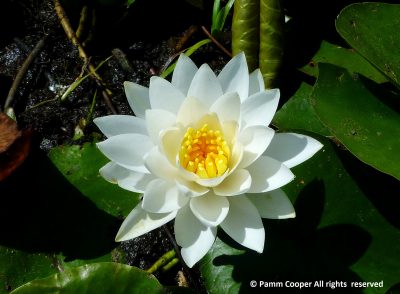
This native water lily occurs in still water that is 5-6 feet deep. The fragrant flowers appear in June and float between the large, circular leaves.
Flowers are open for three days, displaying a cup-shape the first day filled with sugary liquid that attracts the beetles and bees that pollinate them, and on the second and third day pollen is available.
Seeds are dispersed by water fowl such as wood ducks and by water currents. Sometimes a pink form of the flower occurs.
Learn More About White Water Lily
The Connecticut Native Perennial, Tree, & Shrub Availability List
You tested your soil, you receive your soil test report, and now you need to decide on a fertilizer. But in the fertilizer aisle, all you see are triads of numbers: 20-20-20? 0-1-2? 10-5-35?? How do you know which to select? First, it’s important to know that these numbers correspond to the percent by weight of nitrogen to phosphorus to potassium – in that order – in the fertilizer blend. Second, be sure to check the back of the bag – Other nutrients such as calcium, magnesium, and boron, if they are present in the blend, will be listed on the back. The ingredients list will give you a sense of the form of that nutrient – For instance, polymer coated urea is a form of N that will be released slowly over time; Whereas something like potassium nitrate will be highly water-soluble. Most bags will also indicate the effect of the product on the soil pH: It may say something like “potential acidity” or “potentially basic”. For more information about soil testing, be sure to check out our website below! Also, to help calculate what fertilizer you need based on your soil test report, check out this handy calculator tool from Clemson!
By Abigayle Ward, Soil Science Graduate Student
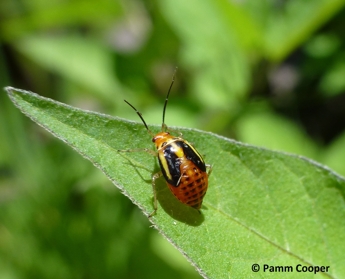
Fourlined plant bugs (Poecilocapus lineatus) are making their presence known in perennial and herb gardens. Damage from both the small nymphs and adults looks the same: black sunken areas on leaves and sometimes stems.
While they only have one generation per year, nymphs emerge over a period of weeks in the late spring/early summer. They should be out of the garden by the end of July.
They can cause considerable cosmetic damage, but they generally do not kill the plants. Adults are neon green with 4 black stripes down the back.
During the growing season, UConn Extension publishes a regular pest alert for both vegetable and fruit producers. Additionally, the New England Vegetable Management Guide offers a lot of information about specific vegetable crops.
While the target audience for these publications is usually commercial growers, home gardeners can learn a lot from these materials including identification and management of common pests in your veggie gardens!
If you ever need confirmation on an ID or have additional questions about what you read in these reports, please do not hesitate to reach out to us at the Home & Garden Education Center! We're happy to help your gardens thrive.

Connecticut is rich in agricultural history, with many operational farms that have lots to offer local markets!
Supporting local CT Agriculture is a way that gardeners can supplement the fresh foods they grow in their garden, with seasonal offerings from year round operations.
Consider attending a local farmers market, joining Community Supported Agriculture (CSA's), or even stopping by your nearest farm stand to see what they have to offer!
This Month’s Newsletter Contributors:
Heather Zidack, Pamm Cooper, Marie Woodward, Abigayle Ward, Holly McNamara
By Amelia Martin, UConn Plant Science Graduate Student
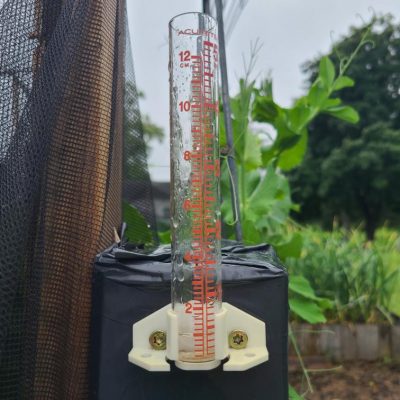
You may have noticed the heavy rains and chilly temperatures last week’s nor ’easter brought to Connecticut. Maybe you were one of many who checked their back window to see their gardens had flooded and their plants are looking worse for the wear. If this sounds familiar and you are curious what garden flooding means for your plants and want to know how to protect them- you found the right article!
A flooded garden is not a unique problem, especially during periods of heavy rainfall, but there are some factors that may contribute to the severity of flooding. Having minimal or poor drainage can amplify the problem, especially if planting in garden boxes with closed bottoms. Soil compaction can contribute to flooding if you are planting directly in the ground. Compacted soil can happen if there has been too much tillage, if wheels or machinery have been over the area, or even from excess foot traffic. Lastly, the layout and landscaping of a yard can contribute to flooding as well. If you placed your garden at the bottom of a hill or there are minimal drainage angles surrounding your garden, water may be pooling up faster than it can drain.
To prevent flooding, check your gutters and make sure they are free from debris and directed to a drain or storm barrel. Put down gravel and mulch to help prevent surface flooding. Avoid cutting your grass too short to maintain strong roots which help to absorb water. Maintain healthy soil to allow for the best water absorption. Dig out a shallow drainage channel if you have the space for it. Consider switching to raised beds with drainage rather than in-ground gardens in easily flooded areas. Try adding native plants to your garden. Native plants have deep roots which helps them absorb excess water and prevent runoff. While handling these issues would be preventative measures, let’s talk about what to do if your garden has already flooded.
Assess the drainage situation and take note of where the water is pooling the most. If flooding is unusual in your garden- there may be something blocking the normal drainage route, which may be a quick fix. If not, knowing where water is likely to pool may help in future garden planning, or help you determine where to make improvements.
Stay off your garden beds. If you step on your soil while it is saturated, it will compact it, ruining the soil’s tilth. Instead, if you need to access your garden beds consider putting a wooden board down to walk on to distribute your weight better.
Re-fertilize your plants. Heavy rain can wash away nutrients out of the soil through a process called leaching. Check the forecast to make sure no more extreme weather is immediately approaching before fertilizing- or you may have to do it again.
Add supports to your plants. The wind and rain may have led to plants falling over. Add in some additional supports to get them upright again and give them a better chance for the next time heavy rain comes.
While having a flooded garden may be a bummer, there are some gardening activities that are actually easier to do in saturated soil! Once the rain stops and the ground is still wet, use this time to weed. The soft ground will make weeds especially easy to pull up- just try not to step on the garden beds. After a rain or a flood, re-mulching is always a good idea. The rain might wash away some previously placed mulch, use this as an opportunity to locate any spots barren of mulch and in need of a re-fill. After a couple days when the soil is soft but not sodden, the ground will be the perfect consistency to dig and put stakes.
Lastly, check for any young plants that didn’t survive the water or any seeds that haven’t come up. Take this as an opportunity to plant new seeds, as seeds do better in already moist soil where they have less chance of being displaced when watered.
At the end of the day, while having a flooded garden may not be the best for your plants, it is not the end of the world. There are a handful of preventative measures that can be taken ranging from backyard renovations to quick fixes- it is about finding what works best for you and your garden.
The UConn Home & Garden Education Center supports UConn Extension’s mission by providing answers you can trust with research-based information and resources. For gardening questions, contact us toll-free at (877) 486-6271, visit our website at homegarden.cahnr.uconn.edu, or reach out to your local UConn Extension center at cahnr.uconn.edu/extension/locations.
This article was published in the Hartford Courant May 31, 2025
Nick Goltz, DPM, UConn Home & Garden Education Center, UConn Plant Diagnostic Lab
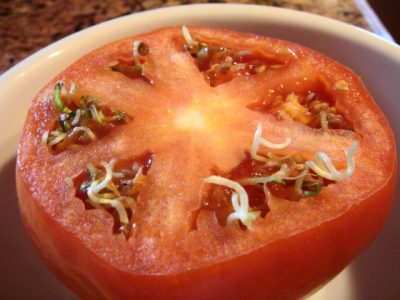
UConn Home and Garden Education Center alum Carol Quish wrote a short blog post about vivipary in 2014 that, over a decade later, is still one of our most-read pieces. Why are folks still interested to read this post after so much time? Because seeing seed vivipary in a tomato you’re about to eat is just so darn weird. To better discuss and understand vivipary however, we should start with a little refresher on seed biology.
Reflecting back on 4th period science class with Mr. So-and-so, you’ll recall that producing a seed is both a distribution and reproduction strategy for plants. Generally, a seed is composed of a developing young plant called an embryo and a nutritious tissue to support the embryo called an endosperm, both of which are encapsulated within a hard seed coat. When an embryo is triggered to begin growing and breaks through the seed coat, many people consider this the stage of germination.
A seed will typically be in a state of dormancy while within the fruit and for a period after fruit harvest and dispersal. This strategy of undergoing dormancy is usually advantageous to the seed so it does not germinate and begin growing under adverse conditions, such as the beginning of winter or before being eaten by a hungry critter. A delicate combination of environmental cues and plant hormones maintain – and break – seed dormancy. When temperature, light, moisture, and other environmental conditions are right for that seed, hormones like gibberellin (GA) and abscisic acid (ABA) will shift in balance and germination will occur. Dormancy is typically maintained when levels of ABA are higher than levels of GA, and is broken when levels of GA are higher than levels of ABA.
When germination occurs while the seed is still within or attached to tissue of the parent plant, this is considered vivipary. Appropriately, the word “vivipary” is Latin for “live birth”. Vivipary is an essential strategy for some plants, such as mangrove trees, to increase likelihood of reaching a safe place to grow. For most plants however, vivipary is considered a physiological disorder or otherwise undesirable outcome as it decreases likelihood for successful establishment and growth, post-germination. Some highly-domesticated plants, like tomatoes, peppers, strawberries, wheat, and corn, are more prone to vivipary than others.
Seed germination within an overripe tomato. Photo credit: J. Copes.
While there isn’t uniform consensus on what combination of factors trigger vivipary, promoting high ABA levels in seeds while they’re still in the parent plant will certainly lower the odds. While there is nothing that can be done to change the genetics of the tomato on your counter, you can take steps to minimize the environmental triggers that would decrease ABA levels. Minimizing free moisture, preventing excessively cool temperatures, and drying, consuming, or processing the seed before the fruit bearing it become overripe are important strategies.
For tomatoes specifically, be sure to harvest them before they are fully ripe! Overripe tomatoes are much more likely to experience vivipary. For the same reason, whether buying or growing your own vine-ripened tomatoes, it’s important to consume them quickly. Furthermore, be sure to store your tomatoes at room temperature and not in the fridge. Not only will they be more likely to have a mealy texture when you eat them, but low temperatures may also increase the likelihood of vivipary.
The next time you happen to take a bite of a tomato filled with seeds that have experienced vivipary, don’t fret! The taste and texture may not be what you were expecting, but they’re perfectly harmless. That said, a better destination for a viviparous tomato may be your garden bed rather than your caprese salad! Seeds that have germinated within the fruit will still grow and eventually produce fruit like any other tomato seedling.
If you have questions about growing tomatoes, or any other gardening topic, call the UConn Home & Garden Education Center (toll-free) at (877) 486-6271. You can also email us at ladybug@uconn.edu, visit our website, www.homegarden.cahnr.uconn.edu, or visit your local UConn Cooperative Extension center.
This article was published in the Hartford Courant and The Westerly Sun May 24, 2025
By Dawn Pettinelli, UConn Home & Garden Education Center
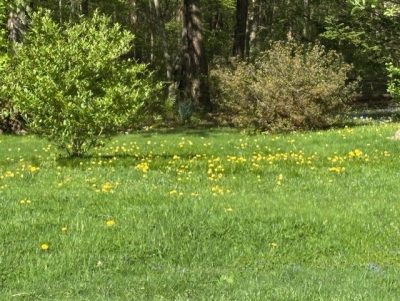
For many, the sight of a lush green lawn brings about the desire to cast off one’s shoes and stroll through the sun-warmed grass feeling the soft verdant carpet below. Lawns, or at least grassy areas, are a ubiquitous part of almost every home outside city limits. While admittedly that perfect lawn is a source of curb appeal and homeowner pride, in recent years considerable attention has been given to the ecological and environmental costs of maintaining turf that is the envy of the neighborhood.
Managed turf grass areas, including golf courses and park areas cover about 8 percent (400 square miles) of the land area in Connecticut. That perfect lawn typically requires supplemental irrigation, fertilizer, regular mowing and often pesticide applications. Water could be better used for drinking, other domestic uses and just left in natural systems. Excess nutrients as well as pesticides can be found in ground and surface waters causing both human health as well as ecosystem problems. While some are turning to electric mowers and blowers, gas-powered equipment dependent more on fossil fuels, are most prevalent (at least in my neighborhood) contributing to climate change.
So what is a residential lawn owner to do? The authors of Redesigning the American Lawn were among the first to coin the term “freedom lawn.” So, what is a freedom lawn? Basically, anything that is green is allowed to grow. That would include dandelions, self-heal, violets, bluets, buttercups, clover and wild strawberries to list a few of those so-called “low growing broad-leaved plants”. By my definition, weeds are plants growing in the wrong place, so the plants are weeds no longer when accepted as part of the lawn.
One of the greatest reasons for encouraging a variety of plants to inhabit turf areas is that the world is facing a critical loss of biodiversity. There are significant declines in beneficial insect, native plant and bird populations, along with other living organisms. While that lush green lawn offers aesthetic pleasure to some, it does little to provide habitat or food for creatures other than problematic ones like grubs or chinch bugs.
A mixed grass- herbaceous plant lawn will contain flowering plants for pollinators and other beneficials. Various plant species have varying root systems. Some have deep taproots that break up compacted soil and bring up minerals. Others have more fibrous root systems that are continuously turning over added organic matter to the soil. A variety of plants along with their root exudates and associated microbes can help aggregate the soil, improving air and water passage. Porosity plus water holding capacity can be increased as well as lessening the potential for topsoil erosion. A healthy plant community usually portends a healthy soil.
Leaning into a freedom or pollinator lawn does not mean digging up one’s entire lawn and reseeding it although that is one option. Two seed mixes that I have seen advertised are Flawn and Fleur de Lawn. Both contain a mixture of fescues, microclover and the latter, some other flowering species. Probably greatest success with these seed mixes would be achieved starting with bare soil.
One can start encouraging biodiversity and pollinator plants by discontinuing the use of herbicides and allowing some flowering plants to move in. Often, they can be mowed before they set seed. When reseeding bare spots, use more drought tolerant fescues or native grasses like little bluestem to reduce the need for irrigation, once established. Higher mowing heights up to 3 or 4 inches will encourage deeper rooting of all plants making them more resilient during periods of drought.
Learn about the benefits of some of the low-growing broad-leaved plants that want to call your lawn home. Clovers add nitrogen to the soil reducing the amount of fertilizer necessary. Violets are host plants for the endangered regal fritillary. Dandelion greens are a great source of vitamins A and C. It is true that many of these plants are not native, but neither are the cool season turf grasses normally found in lawns.
In many yards, keeping part of it in lawn is essential for children’s play and sports activities, pet areas and entertaining. Take a tour of your yard and determine where a lawn makes sense and where it might be more appropriate for woody plants, ornamental beds or even a vegetable garden. Steep slopes or perpetually shaded areas may be best for groundcovers. Areas where water frequently collects after heavy rains might be more suitable for a rain garden.
However small, every effort to encourage biodiversity, provide for our beneficials and improve soil health is a step in the right direction. Rethinking your lawn areas might be a good place to start.
For information on lawns or any other gardening topic, call the UConn Home & Garden Education Center (toll-free) at (877) 486-6271 or email us at ladybug@uconn.edu or visit our website, www.homegarden.cahnr.uconn.edu.
This article was published in the Hartford Courant May 18, 2025
By Pamm Cooper, UConn Home & Garden Education Center This spring has been a dramatic one as ornamental trees and shrubs are putting on quite a colorful floral display. Many deciduous ornamentals including redbuds, forsythia, crabapples, fruit trees, quince azaleas and many others were not adversely affected by last summer’s drought and the cold, windy winter and frozen soils that followed. A lesser noticed but significant drama is the negative effect these same environmental conditions had on ornamental and native evergreens.
Rhododendrons and ‘Green Giant’ arborvitae seemed to suffer the most damage followed by cherry laurels and hollies. Last year’s drought conditions that extended into late fall combined with very windy winter conditions and frozen soils were tough for some evergreens. Winter desiccation injury on broadleaved and needled evergreens causes foliage browning when plants cannot take up the water needed to keep foliage healthy. Damage to many rhododendrons and some azaleas could be seen during the winter and is still evident this spring. Buds may provide new leaves by June if branches are still alive.
In contrast, 'Green Giant’ arborvitaes suddenly showed symptoms after warm weather began this spring. This was evident especially in trees on windy sites. Needles are brown or off color and time will tell if they are able to recover. If branch tips are flexible and show new buds, growth may resume. Prune any dead branches that show no signs of recovery.
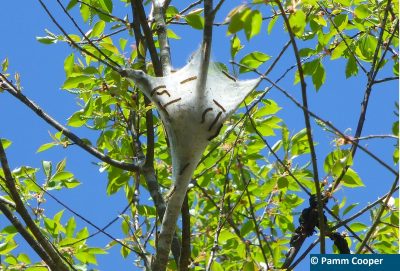
Eastern tent caterpillars have hatched from overwintering egg masses on native black cherries. Silken nests are evident located in crotches of these trees. Caterpillars feed outside the tents at night and hide in them during the day. There is only one generation, and feeding is generally finished by late June. Trees have time to leaf out again to remain healthy during the growing season. Birds like cuckoos and vireos will rip tents apart to feed on the caterpillars.
If you have Oriental lilies, be alert for the lily leaf beetle. This bright red insect can severely defoliate these lilies. Adults overwinter in soil close to the plants they were feeding on the previous season. They appear as soon as lilies begin new growth above the ground. Leaf undersides should be checked for eggs and larvae and crushed when found. Leaves can be treated if needed with a product that larvae will ingest as they feed on the treated leaves. Never spray flowers with any insect control product and always follow directions as written on the product label.
Snowball aphid feeding damage is noticeable on the new leaves of European cranberry bush and snowball viburnums. As the aphids feed on the new leaves and twigs, leaves curl and twigs twist in response to aphid feeding on the sap. Aphids can be found by uncurling the leaves. Treatment is difficult as they are not out in the open where contact control products can reach them. Feeding should end within two months of egg hatch. These aphids overwinter as eggs laid on the branches of host viburnums.
Viburnum leaf beetles, Pyrrhalta viburni, are another significant pest of ornamental and native viburnums. They’re active soon after viburnums leaf out. Damage will be seen as larval populations grow and they skeletonize leaves. Some viburnums may suffer complete defoliation. This pest prefers arrowwood, European cranberry bush or American cranberry bush viburnums. Try switching to resistant varieties such as V. plicatum and Korean spicebush viburnum V. calesii if leaf beetles are a chronic pest.
If anyone has small St John’s wort shrubs or certain weigela cultivars that seem to be dead, wait and see if new growth resumes as it gets warmer and sunnier. The smaller St. Johns’ wort shrubs die back in fall, leaving brown stems with withered fruit. Prune these back almost to the ground as basal growth appears. Some weigela cultivars are just slowly getting started, while others are already full of leaves. Do not give up these plants but wait and see what happens in May.
As always, our UConn Home and Garden Education Center office staff welcomes any questions gardeners may have concerning landscape and garden plants problems. Across the New England region, people are having much the same problems as we are having in Connecticut from the winter weather, but we can hope that plant recovery be swift and complete. Enjoy the growing season and stay alert- scout for pests and other problems before they get out of hand.
The UConn Home & Garden Education Center supports UConn Extension’s mission by providing answers you can trust with research-based information and resources. For gardening questions, contact us toll-free at (877) 486-6271, visit our website at homegarden.cahnr.uconn.edu, or reach out to your local UConn Extension center at cahnr.uconn.edu/extension/locations.
This article was published in the Hartford Courant May 10, 2025
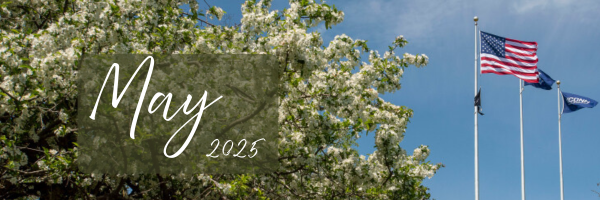
“A garden is a grand teacher. It teaches patience and careful watchfulness; it teaches industry and thrift; above all, it teaches entire trust.”
— Gertrude Jekyll
Gardening comes in all shapes and sizes, whether its a few pots on the patio, a large in-ground bed, or somewhere in between. We love the challenge of getting the most out of our gardens and finding new methods to increase efficiency and yield. There's many techniques out there - which one is best for you?
Click on each title to learn more and keep in mind that these are only a few of many techniques gardeners use to maximize their productions!
Intercropping
This practice focuses on growing two or more crops in close proximity to maximize the use of space in the garden. Plants need to be of similar culture in terms of watering and care needs in order to be successful. Often, timing of harvest can be a significant player in this system. Planting radishes in between broccoli, for example, ensures that the radish will be harvested before the broccoli needs additional space to produce its crown.
Companion Planting
While it may seem easy to use companion planting and intercropping interchangeably, they are two different practices. Companion planting focuses more on the relationships between plants and their environment. For example, some companion plants benefit others by deterring pests or fixing nitrogen into the soil. These complex relationships add benefit to your garden while also maximizing space.
Succession Planting
This method involves re-planting immediately after harvest to utilize the space for as long as possible. For example, planting escarole and lettuce once warm season vegetables have been harvested can help extend the gardening season. Alternatively, planting peas from seed every 2 weeks during the months of April & May ensures staggered harvest when compared to a single planting ready for harvest at the same time.
Square Foot Gardening
Looking to create an organized and efficient vegetable garden this growing season? Try using the square foot gardening method. In this technique, the growing area is divided into small sections, each one square foot in size. The result is an orderly garden grid with a different plant species in each square. Construction is simple and can be done with minimal materials.
Container Gardens
We are fortunate that the availability of container-friendly production plants has been increasing over the years! If your garden space is limited, seek out plants that are specifically intended for containers.
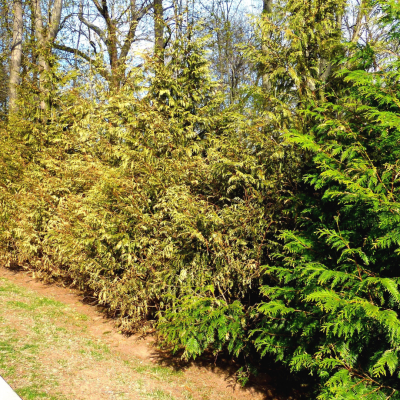
Connecticut's woody ornamentals have suffered from a unique challenge this past winter season: the lingering effects of a moderate drought during the preceding fall, along with cold temperatures and harsh winds. This combination of factors poses a threat to the health and vitality of trees and shrubs, exacerbating the typical stressors of winter in New England.
Many gardeners even reported a delayed response, noting that their evergreens looked okay throughout the winter and early spring.
While drought-stressed plants are generally more susceptible to winter injury, this year's moderate fall drought has weakened many woody ornamentals, leaving them vulnerable to frost damage, branch dieback and pathogens, which become opportunistic when woody ornamentals are under stress.
Monitoring your trees and shrubs over the coming season will help you mitigate any further damage. Providing supplemental water when less than 1" of rain is forecasted for the week may also help plants out of this stressful time. Checking the soil before watering will help you avoid overwatering, which can cause its own host of issues.
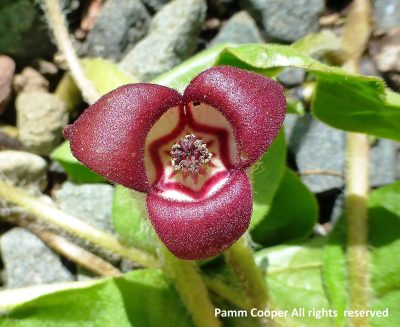
Wild ginger, Asarum canadense, is a native plant that is a good choice as a shaded groundcover. Found naturally in woodlands in the eastern U.S., flowers are often overlooked as they are hidden near the ground below the leaves of this low-growing plant. Not considered edible, it is unrelated to the ginger used in cooking.
Shopping for native plants this spring? UConn has created a valuable resource that not only identifies CT Native plants, but helps you find the garden centers that carry them!
The Connecticut Native Perennial, Tree, & Shrub Availability List
To Keep, or not to Keep? Clover Edition
As we move into the summer the common plant clover starts to pop up everywhere throughout your lawn! However, instead of hand pulling or digging out the “weed”, should you actually keep it in your yard this summer? The answer is: yes! Clover is actually extremely beneficial to the environment in multiple different ways, and is also more drought tolerant, requires less fertilizer than grass, and attracts pollinators such as bees! This plant is a nitrogen fixing legume, which forms a symbiotic relationship with Rhizobia bacteria that start to form bumps that are able to extract the nitrogen from the atmosphere. When the nitrogen is extracted, the Rhizobia helps turn it into a usable form for the legume, and it “fixes” it within the plant. Clover is a great plant to keep in your lawn this summer!
By Zaira O’Leary, University of Connecticut Sustainable Plant and Soil Science Undergraduate
During the growing season, UConn Extension publishes a regular pest alert for both vegetable and fruit producers. Additionally, the New England Vegetable Management Guide offers a lot of information about specific vegetable crops.
While the target audience for these publications is usually commercial growers, home gardeners can learn a lot from these materials including identification and management of common pests in your veggie gardens!
If you ever need confirmation on an ID or have additional questions about what you read in these reports, please do not hesitate to reach out to us at the Home & Garden Education Center! We're happy to help your gardens thrive.

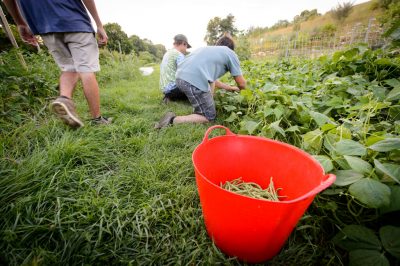
Connecticut is rich in agricultural history, with many operational farms that have lots to offer local markets!
Supporting local CT Agriculture is a way that gardeners can supplement the fresh foods they grow in their garden, with seasonal offerings from year round operations.
Consider attending a local farmers market, joining Community Supported Agriculture (CSA's), or even stopping by your nearest farm stand to see what they have to offer!
In spring, some farms and farmers markets even offer plant starts for sale to be planted in your home garden.
This Memorial Day we also recognize ctveterangrown.org as a valuable resource for both veteran farmers and community members who wish to support Veteran-Owned or Operated Farms in CT.
This Month’s Newsletter Contributors:
Heather Zidack, Pamm Cooper, Emily Leahy, Zaira O'Leary
By Marie Woodward, UConn Home & Garden Education Center

If you are wondering whether that shrub, flower, or tree that you saw in a magazine or catalog will grow well in your garden, using a hardiness zone map is your best bet to ensure success.
A hardiness zone map is a tool that divides a geographical area into distinct zones based on average annual minimum winter temperatures. These maps are used by gardeners and farmers around the world to determine which plants are most likely to thrive in a particular region. Each country has its own hardiness map that correlates to their climate. In the United States, the USDA publishes a hardiness zone map, which covers all fifty states and includes Puerto Rico, Guam, American Samoa, and the U.S. Virgin Islands. It uses climate data collected over many years from weather stations throughout a specific region. Then the data is analyzed to determine average minimum winter temperatures from different areas.
The concept of hardiness zones was first introduced in 1927 by Dr. Alfred Rehder. Rehder worked at Harvard's Arnold Arboretum as a botanical taxonomist. He wanted to address the challenges gardeners and growers faced in selecting plants suited to their local climate. Prior to Rehder’s map, there was no standardized system for categorizing plants based on their ability to survive winter temperatures. His hand-drawn map featured eight hardiness zones and was based on the lowest winter temperatures recorded in various regions across the country. Rehder aimed to provide a practical tool for gardeners and growers. His map made it easier for them to choose plants with the best chances of survival in their region, ultimately contributing to more successful gardens and agricultural endeavors. Rehder’s innovative approach recognized the importance of adapting agricultural practices to local climates. In the 1960s, the USDA adopted and adapted Rehder's concept, creating the first official USDA Plant Hardiness Zone Map.
Since its initial release, the USDA Plant Hardiness Zone Map has been updated several times to reflect changes in climate and the availability of more accurate data. The latest update of the USDA hardiness map was released in November 2023, jointly developed by the USDA's Agricultural Research Service (ARS) and Oregon State University's PRISM Climate Group. This update incorporates data from 1991 to 2020, covering a broader range of weather stations than previous versions. One of the key findings from this update is that the contiguous United States has become approximately 2.5 degrees Fahrenheit warmer on average compared to the previous map. As a result, around half of the country has shifted into the next warmer half zone, while the other half has remained unchanged. The updated map still consists of 13 zones, but now offers more detailed information on temperature ranges within each zone, including 10-degree zones and 5-degree half zones. Connecticut has two hardiness zones each of which is divided into half zones; (6a,6b); (7a,7b), to better reflect the temperatures in the state over the past few decades.
The importance of hardiness zones lies in their ability to help gardeners and farmers choose plants that will thrive in their specific region. By selecting plants appropriate for their zone, growers can reduce the risk of frost damage and increase their chances of a successful growing season. However, due to unexpected temperatures outside the average range, there is no guarantee that a plant won’t suffer but it does reduce the risk of plant damage. In addition to gardeners, researchers use hardiness zones to study the spread of insects and exotic weeds, while the USDA Risk Management Agency uses the map to help determine crop insurance rates for commercial growers.
While the USDA Plant Hardiness Zone Map is an invaluable tool, it is important to note that it is not the only factor gardeners and farmers should consider when selecting plants. Other factors, such as soil type, precipitation, and local microclimates, can also impact plant growth and survival. Gardeners should use the map as a starting point and supplement it with local knowledge and research to make the best plant selections for their specific needs.
The development of the USDA Plant Hardiness Zone Map is a testament to the importance of adapting agricultural practices to local climates. Since its inception nearly a century ago, the map has evolved to reflect changes in climate and incorporate more accurate data. Today, the map remains an essential resource for gardeners and researchers alike, helping them to better understand and navigate the complexities of plant growth in the diverse regions of the United States. Knowing a plant’s hardiness zone when selecting that shrub, tree or flower will help you grow the garden of your dreams.
The UConn Home & Garden Education Center supports UConn Extension’s mission by providing answers you can trust with research-based information and resources. For gardening questions, contact us toll-free at (877) 486-6271, visit our website at homegarden.cahnr.uconn.edu, or reach out to your local UConn Extension center at cahnr.uconn.edu/extension/locations.
This article was published in the Hartford Courant May 3 2025
We Asked Arborists When to Prune Dogwood Trees, and They All Said the Same Thing
The Spruce – Heather Zidack and other professionals give their insight on pruning Dogwood Trees